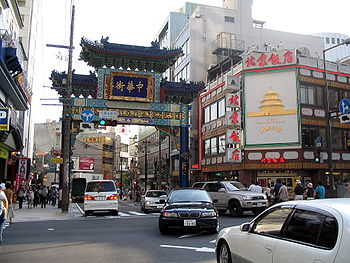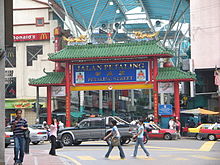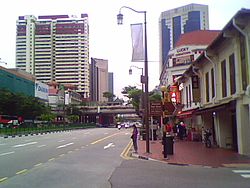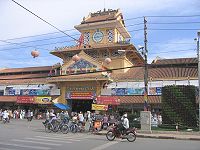- Chinatowns in Asia
-
Chinatown Chinatowns in Africa Chinatowns in Asia Chinatowns in Europe Chinatowns in Latin America Chinatowns in the Middle East Chinatowns in Canada and the United States Chinatowns in Oceania
Chinatowns in Asia are widespread with a large concentration of overseas Chinese in East Asia and Southeast Asia and ethnic Chinese whose ancestors came from southern China - particularly the provinces of Guangdong, Fujian, and Hainan - and settled in countries such as Brunei, Cambodia, Indonesia, Laos, Malaysia, Myanmar, Singapore, the Philippines, Thailand, Vietnam, Japan and Korea centuries ago—starting as early as the Tang Dynasty, but mostly notably in the 17th through the 19th centuries (during the reign of the Qing Dynasty), and well into the 20th century.During the years of European colonialism in Southeast Asia, many Chinese arrived in these countries to find work, often causing ethnic tension between them and the native population; in particular, between ethnic Malaysian Chinese Buddhists and Malay Malaysian Muslims in the 1960s. These ethnic Chinese arrived from southern mainland China and were mainly Chinese people of Cantonese (Vietnam, Malaysia, Indonesia, Cambodia, Myanmar), Hakka (Indonesia, India), Hainanese (Vietnam), Hokkien (Philippines, Singapore, Malaysia, Indonesia, Myanmar), and Teochew/Chaozhou (Cambodia, Laos, Thailand) stock.
The largest Chinatown in Asia is located in Yokohama, Japan. (See Yokohama Chinatown). These early groups did not identify as hailing from Mainland China, but from their subregion of origin; for example, the Cantonese did not relate to the Hakka people.
The ethnic Chinese represent a large minority population in most of these countries—with Singapore being the exception where Chinese-origin Singaporeans form the majority of the population. Of all overseas Chinese in Southeast Asia, however, the ethnic Chinese in Vietnam tend to retain the strongest ties to the Chinese culture and language and, hence, remain relatively isolated from the ethnic Vietnamese majority.[citation needed] Chinese Indonesians and Chinese Filipinos have adopted to Indonesian and Filipino ways, respectively. Thai Chinese have generally assimilated into the larger Thai population.
Contents
Specific Asian Chinatowns
Cambodia
Phnom Penh's Chinatown is on Street 136.
Cambodia experienced ethnic Chinese settlement beginning in the 15th century. In recent decades, a large number of new and more recent Mainland Chinese immigrants have immigrated to Cambodia. Several Cambodian cities are known or suspected to have started out as Chinese settlements.
India
Most of the Chinese of Calcutta live in or near is a Chinatown in Calcutta. Many Hakkas live in a community known as Tangra, which is dominated by leather tanneries (the Hindu majority will not touch cattle) and Chinese restaurants. Another Chinatown is in Byculla, Mumbai; however it has diminished in population as many of its Indian-born Chinese ethnic residents have migrated, mainly to major immigrant destinations such as Australia, Canada,the United Kingdom and the United States. [1]
Indonesia
Glodok district of Jakarta on Jalan Gajah Mada (Gajah Mada main street), the Pancoran streets, Jatinegara in East Jakarta and Krendang in West Jakarta has a large ethnic Chinese population. In 1998, many Chinatown businesses were burned by indigenous Indonesians and the area suffered from arson during race riots, known as Jakarta Riots of May 1998. Many Chinese left Indonesia when their fellow countrymen persecuted them, but there are still large numbers of Chinese Indonesians remain. Two century before, Dutch East India Company in 1740 also massacred them.[1]
Other Indonesian Chinatowns include Gang Semawis and Jalan Pekojan in Semarang. There are also numerous Chinese Indonesians in Surabaya - East Java, Bangka Belitung - Pangkal Pinang, Sungailiat, Toboali and Muntok (with Hakka majority) , Medan - North Sumatra (with Hokkien majority), Pontianak - West Kalimantan (TeoChew majority) and Singkawang - West Kalimantan (Hakka majority, almost 70% of city population).
A Chinatown in Indonesian is also known as Pecinan.
Japan
In Japan, ethnic Chinese immigrants are called kakyō. The largest Chinatown in Asia and one of the largest in the world is located in Yokohama. (See Yokohama Chinatown) (Japanese: Chūkagai). The city of Kobe has a growing Chinatown (See Kobe Chinatown) (Japanese: Nankinmachi). In Nagasaki, its Chinatown (See Nagasaki Chinatown) (Japanese: Shinchimachi) was founded in 1698 AD. Most Chinese immigrants in Japan were from Taiwan who arrived during the Japanese colonial period.
Korea, South
Main article: Chinese people in KoreaSouth Korea's Chinatowns are located in Incheon and Seoul. Seoul's Chinatown is unofficial. A newly planned Chinatown was built in suburban Goyang (Ilsan) in 2005.
Incheon's Chinatown is Korea's only official Chinatown. It is in Jung-gu and was formed in 1884. It used to be the largest such Chinatown in South Korea before the exodus of Chinese from the county. In 2002, to capitalize on the large number of Mainland Chinese visitors who were visiting South Korea, the Inchon city council planned to revive its moribund Chinatown at a cost of US $6.2 million (worth about 6.5 billion South Korean won). It claims to be the largest Chinatown in South Korea, and features an 11-metre high Chinese-style gateway.
Busan is also considering reviving its Chinatown.
Due to institutionalized anti-Chinese discrimination during the Park Chung Hee administration and lack of economic opportunities, many ethnic Chinese left South Korea during the 1960 and 1970s for Taiwan or the United States.[2] Since then the actual Chinese populations of many Chinatowns in South Korea declined. Many business in these Chinatowns are actually owned by ethnic Koreans.
Laos
Vientiane contains a Chinatown on Samsenthai Road.
Malaysia
Main article: Malaysian ChineseWith around a quarter of the Malaysian population of Chinese origin, urban districts with a large concentration of ethnic Chinese are to be found across the country. The term Chinatown is rarely used to refer to such places locally except for tourism purposes, particularly in reference to Petaling Street - the centre of Kuala Lumpur's Chinese business district, and is predominantly Cantonese-speaking.
In the north of the country, the population of Georgetown on the island of Penang is largely Hokkien-speaking, and close to 90%[3] of the population is of Chinese origin. Other urban areas with high proportion of Chinese population in the city centre include Kuching (90%[4]), Ipoh (82%[5]), Kota Kinabalu (78%[6]) and Malacca (62%[7]).
With such high concentration of urban Chinese, Malaysian cities rank among the largest Chinatowns in the world.
Myanmar
Chinatown in Myanmar is in Yangon. Most Chinese came from mainland China.
Pakistan
There is a sizeable community of Chinese people in Pakistan, based largely in urban centres. The areas of Clifton and DHA in Karachi have many Chinese restaurants and businesses and are sometimes dubbed as Chinatown.[8]
Philippines
The best-known Chinatown in the Philippines is the district of Binondo in Manila. Many prominent Chinese Filipino families have roots in this district. Among the attractions of Binondo is Divisoria, a shopping area popular with people engaging in bargain shopping.
Chinese settlement—who were predominantly Hokkien—in the Philippines pre-dates the coming of the Spanish in 1521. Chinese merchants have been trading with the indigenous tribes of the islands since the 8th century. During the Spanish occupation, the Chinese held an intermediate place in Filipino society as middlemen between the Spanish upper-class and the native Filipinos or indíos, a derogatory term also used by the Spanish to refer to Native Americans. However, they were forced to live in ghettos such as Binondo. During the rule of Ferdinand Marcos, bitterness against Chinese Filipinos grew, starting in 1972. Most of the community went to Venezuela, or to North America — especially United States — Australia, or any other countries. In the first ever visit to Manila's Chinatown by a Filipino president, President Gloria Macapagal-Arroyo, who is of part Chinese descent herself, recognized the efforts and contributions of Chinese Filipinos.
As of 2006, plans have been drawn up to construct a newer, but synthetic, Chinatown in shopping mall form along Diosdado Macapagal Avenida in Manila Bay area of Manila, which will rival the nearly 400-year-old original Chinatown in the Binondo district. It is dubbed the “Neo Chinatown” to be designed in traditional Chinese architecture and it is joint venture of local Chinese Filipino and Mainland Chinese investors. Neo Chinatown will also attempt to replicate the vibrant nightmarket scene found on the streets of Hong Kong and Taipei.
Russia
Many early immigrants to Russia were from the provinces of Hebei, Shandong, Shaanxi and Shanxi in Mainland China. The earliest of immigrants come in the 1860s and 1870s, mainly to the Siberia. They helped build the Trans-Siberian Railroad. An early Chinatown in Vladivostok was established in 1860s. Nearly all ethnic Chinese in Russia returned to Mainland China after the Alexander Kerensky and his liberal supporters took power in Russia in 1917.
A Chinatown district has cropped up in the Ural city of Yekaterinburg. [2]
The Chinatown of Ussuriysk, north of the city of Vladivostok and near the Heilongjiang province of mainland China. It is known in Russian as kitaiskii gorodok (Китайский Городок). Most ethnic Chinese living in this easternmost portion of Russia are from Mainland China. (photo)
- See also: Chinatowns in Europe#Russia
Singapore
Main article: Chinatown, SingaporeSingapore, a multi-racial, but predominantly Chinese, country has a relatively large Chinatown in a district to the south of the river originally designated for Chinese settlement by Sir Stamford Raffles. It remains known as Chinatown in English. The local Chinese name for the area is Niú chē shuǐ (牛车水, lit. 'ox cart water') on Telok Ayer Street and is also the name of the MRT (heavy rail) station that serves it. The station is located on the major Eu Tong Sen street. Although the area around the station, a shopping street, mainly serves as a tourist destination selling souvenirs, not far from this are a number of locally frequented areas including a number of restaurants, vegetable and meat markets, the Smith Street night market, traditional medicine outlets, several malls, apartment complexes, and Chinese temples including the recently completed Buddha Tooth Relic temple, and the Thian Hock Keng Temple.
Perhaps as an indication of the multi-racial mix in Singapore, a Muslim mosque and the Sri Mariamman Hindu Temple can also be found off the main street.
In 1989, several areas in the Singapore Chinatown district were earmarked by the Urban Redevelopment Authority as conservation areas. Under that programme, the historic sub-districts of Kreta Ayer, Tanjong Pagar, Telok Ayer, Ann Siang Hill and Bukit Pasoh were restored to add variety to the modern landscape, and more importantly, serve as reminders of the past. Many of the buildings restored in Singapore Chinatown were shophouses and they now house many small-medium businesses including upmarket boutiques, cafes and bakeries, advertising agencies, architectural and law firms, internet start-ups, boutique hotels, spas and fitness schools. Many decades-old traditional entities like medicine outlets, old-style coffee stalls, and clan association make unlikely neighbours with the newer businesses.
Since Singapore's population is largely of Chinese heritage, the Chinatown of Singapore is not much of an immigration centre as it is in other countries, but more of a shopping and eating district and in many cases more upscale than outside it. It is also perceived as more of a major building preservation project than a real Chinatown per se.
- See also: Chinatown.SG
Thailand
Chinese Thais of Teochew (Chaozhou) descent are the dominant group of ethnic Chinese, with smaller numbers of those of Cantonese and Hakka origin as well. The Thai Royal Family is of Chinese descent in the paternal line.
Bangkok The Chinatown (Thai: Yaowarat) of Bangkok is located on Yaowarat Road and Sampeng Lane.
Phuket The city of Phuket is home to Thailand's second Chinatown, which are on Phang Nga Road, Thalang Road, Krabi Road, Phuket Road, Ratsada Road, Yaowarat Road, Deebook Road and Thepkrasattree Road Phuket was founded by early Chinese settlers.
Mae Salong There is a Chinese community in northern Thailand, in a town called Mae Salong near Myanmar. After the defeat and exile of Kuomintang from Mainland China by forces led by Mao Zedong, several Kuomintang army divisions in the Yunnan province fled into neighboring Myanmar. After being expelled from that country, the Mainland Chinese veterans fought Thai communists on behalf of the Thai government and were granted citizenship. Mae Salong was established by veterans of the Kuomintang army 93rd Division. Many of Thai-born Chinese generations have relocated to Taiwan, though their fathers and grandfathers, refuse because of an owed apology from the KMT for refusing them in the 1950s and 1960s. They have since made a retirement home-styled town, called "the home to the glorious people" (榮民之家) Today, Mae Salong is a spot for tourists from Taiwan and Mainland China.
United Arab Emirates
There is a Dubai Chinatown being constructed in Dubai, United Arab Emirates which upon completion may be the world's largest Chinatown.
Vietnam
Ethnic Chinese have been moving to Vietnam for centuries. During the transition of power from Ming Dynasty to Qing Dynasty in China, many anti-Qing elements fled prosecution and came to Vietnam. To avoid angering the Qing government, Vietnam government decided to send them south to populate the scarcely populated area. They pioneered many settlements in the south of the country including Saigon (Sài Gòn - Vietnamese polyphonic version of the Cambodian name), or as it is known today, Ho Chi Minh City (Hồ Chí Minh). Ho Chi Minh City's Chinatown is the Cholon district which has been a stronghold for the Chinese-Vietnamese community since the late 1770s, when many Cantonese and Teochew Chinese arrived during French imperialism. Its main thoroughfares are Nguyen Trai Street (Nguyễn Trãi) and Tran Hung Dao Street (Trần Hưng Đạo). The Cholon area was the bastion of ethnic Chinese Vietnamese free enterprise until the Vietnamese communist government confiscated private property in the area.
Prior to Sino-Vietnamese War the Vietnamese government decided to expel the Sino-Vietnamese from the Northern part of the country hence the second wave of boat people many of whom went to China.
After the period of the Vietnam War and Sino-Vietnamese War (the late 1970s and early 1980s), many Chinese Vietnamese (called in Vietnamese the Viet Hoa) along with their ethnic Vietnamese, or the Viet Kinh, compatriots fled the country as "boat people". However, this third wave were mostly ethnic Vietnamese. As a result, there are many overseas Chinese Vietnamese communities in Australia, Canada, France, Germany, and the United States. Nevertheless, Vietnam still has a remnant ethnic Chinese community.
Discrimination and anti-Chinese sentiment
In 1997, the Asian financial crisis loomed over Asia and caused political turmoil, especially in Indonesia. Although several Southeast Asian leaders such as Malaysia's Prime Minister blamed the Western-dominated International Monetary Fund for the economic problems, many Indonesians took to the streets and blamed Chinese Indonesians who dominated the Indonesian economy for their economic woes. Angry Indonesian rioters destroyed Jakarta's Chinatown area, businesses run by ethnic Chinese, and homes throughout in the country.
External links
- Chinatown.SG - Singapore Chinatown's official website
- http://www.chinatownology.com Singapore Chinatown
- Welcome to Hakka Community - Twilight descends on Calcutta's Chinatown
- Singapore's Chinatown
- The Chinatown of Malacca, Malaysia
References
- ^ image: Bird's eye view of Batavia showing the massacre of the Chinese
- ^ Kim, Hyung-jin (2006-08-29), "No 'real' Chinatown in S. Korea, the result of xenophobic attitudes", The Hankyoreh, http://english.hani.co.kr/arti/english_edition/e_national/152641.html, retrieved 2006-12-08
- ^ Malaysian Electoral Commission ethnic composition of the state of Penang, 2008
- ^ Malaysian Electoral Commission ethnic composition of the state of Sarawak, 2008
- ^ Malaysian Electoral Commission ethnic composition of the state of Perak, 2008
- ^ Malaysian Electoral Commission ethnic composition of the state of Sabah, 2008
- ^ Malaysian Electoral Commission ethnic composition of the state of Malacca, 2008
- ^ Chinatown (Karachi)
Chinatowns Africa South Africa: JohannesburgAsia India: Kolkata · Makum (closed) · Mumbai (closed), Indonesia: Jakarta, Iran: Mahale Chiniha, Japan: Kobe · Nagasaki · Yokohama, Malaysia: Kuala Lumpur, Myanmar: Yangon, Pakistan: Karachi, Philippines: Manila, Singapore Singapore, South Korea: Incheon, Thailand: Bangkok, United Arab Emirates: Dubai, Vietnam: Ho Chi Minh City (Saigon)Europe Latin America Argentina: Buenos Aires, Brazil: São Paulo, Costa Rica: San José, Cuba: Havana, Mexico: Mexicali · Mexico City, Peru: LimaNorth America Canada: Calgary · Edmonton · Lethbridge · Montreal · Ottawa · Toronto · Vancouver · Victoria · Winnipeg
United States: Boston · Brooklyn · Chicago · Cleveland · Flushing · Honolulu · Houston · Las Vegas · Los Angeles · Newark · New York · Oakland · Oklahoma City · Philadelphia · Portland · San Francisco · Seattle · Washington D.C.Oceania Categories:- Chinatowns in Asia
- Anti-Chinese sentiment in Asia
Wikimedia Foundation. 2010.






